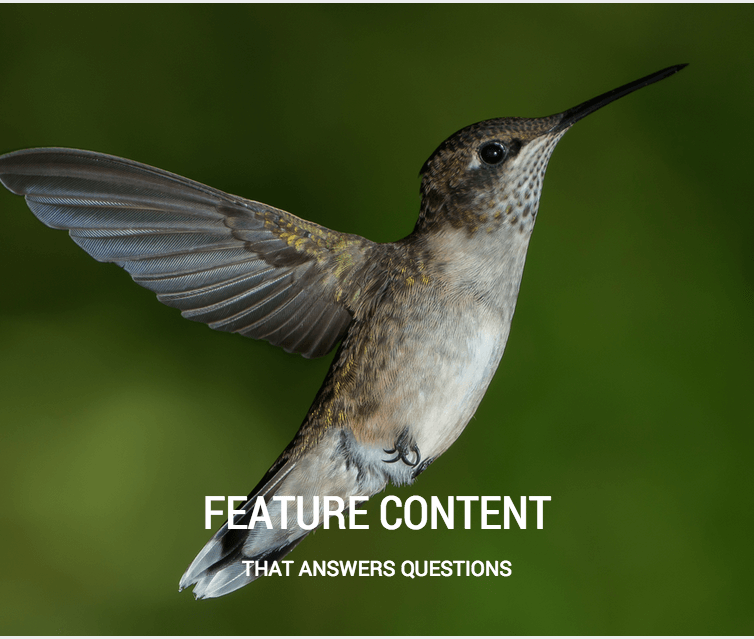Nearly two years ago, Google changed their algorithm (and called it Hummingbird) to accommodate the way people search the web—by featuring content that answers questions.
Think about it from your perspective. When you do a Google search, how often are you asking a question?
If I let my search bar autofill, I find things such as:
- What is my IP address?
- What time is it?
- Who won the fight last night?
- Why is Baltimore rioting?
- Why is the sky blue?
- Why are there riots in Baltimore?
- Why are they rioting in Baltimore?
Those aren’t necessarily the things I’ve searched (though I’m fairly certain I’ve looked up that first one at least 100 times). Rather, Google autofills some of the most popular questions of the day.
The point is that we tend to ask questions when we search and Hummingbird increases your search rankings when you feature content that answers questions your customers or prospects might ask.
Finding Sources on Twitter
I was reminded of this interesting way to produce content when I recorded FIR with Shel Holtz yesterday (more on that tomorrow).
He found an article on Medium by Daniel Victor that explores how you should search on Twitter, specifically (though it would work on Google, too), by adding one word.
Victor is a staff editor on the news desk of The New York Times. He was working with a colleague to find people who have been on flights with Hasidic Jewish men and either asked to move seats or was on a flight that was delayed because they needed to accommodate the gentleman.
The sources could be male or female, but even better if they were female and happened to be the person the man wouldn’t sit next to (for religious reasons).
They were aware of four incidents between the U.S. and Israel, but wanted to find more.
So they took to Twitter to find passengers on those four flights, and on other flights where similar conflicts may have happened.
Keywords Don’t Necessarily Work
They ended up finding 13 possible sources and the story ran on page one in print just a few weeks ago.
The five people they quoted were all found through a Twitter search.
But what’s interesting is HOW they found the sources.
Because our content marketing world is made up by a good portion of search engine optimization, we tend to think in keywords.
Sure, we ask questions, but we also use specific keywords to find what we need.
Yesterday (because I wasn’t paying $100 and I had no interest in staying up late to watch), I wanted to see who won the fight.
I also didn’t know how to spell Pacquiao without looking it up. So I used “Mayweather fight results” to get what I needed.
Mayweather + fight+ results are my keywords.
If I were going to create content around that answer, and to fulfill the needs of Hummingbird, I would use, “Who won the Mayweather fight?”
So, like most journalists, when Victor was tasked with finding sources, he started with Hasidic and flight.
The One Word to Use in Searches
But the search came up with a lot of noise. So he added Jew and Orthodox and Jewish. Then he added plane.
But even adding those words wasn’t enough. He really had to figure out what people use…the people who aren’t trained to create content around keywords.
The word?
Me.
(And its “close cousin my,” he says).
It’s fascinating to see how adding the word “me” brings back super targeted results.
In the Medium article, he breaks down each tweet of the five sources so you can see what he means. I recommend heading over there to check it out (I’ll link it here again).
Feature Content that Answers Questions
The point is we have to shake our SEO-addled brains and create content that answers questions people want to know if they are going to buy from us.
Things such as:
- Revise your FAQs. Nearly every website has frequently asked questions, but they aren’t set up to be search- or human-friendly. When writing the headlines (the questions), I suggest entering the first few words into Google and see what it autofills. If it’s something people ask when searching, you’re going to have some options there. Use what you find, rather than making something up.
- The questions become headlines. So, instead of writing a headline you think the search engines will like, write the headline as a customer or prospect might ask it. For instance, what is content marketing? Or what is the one word I should use when searching for sources?
- Create content that answers questions customers ask. Every organization, no matter what you sell, has a core group of questions that get asked all the time. Create content around those questions and use your SEO brain to work with Hummingbird. For instance, “How do I know if my PR is working?” or “When will my PR person start getting results?” (I hear that second one A LOT!) Notice I use “my” in those questions, to use Victor’s recommendation.
- Use your sent mail. Go into your mailbox and search the last seven days. How often have you answered the same question in email? I’d venture to guess the answer is several times. Use those emailed questions to create content. You might end up with things such as, “How does this lock work in my door?” or “Will this software upgrade affect my website?”
It’s an interesting way to think about content creation, but it will deem you most useful to both search engines and humans.
What other content can you create that answers questions?
